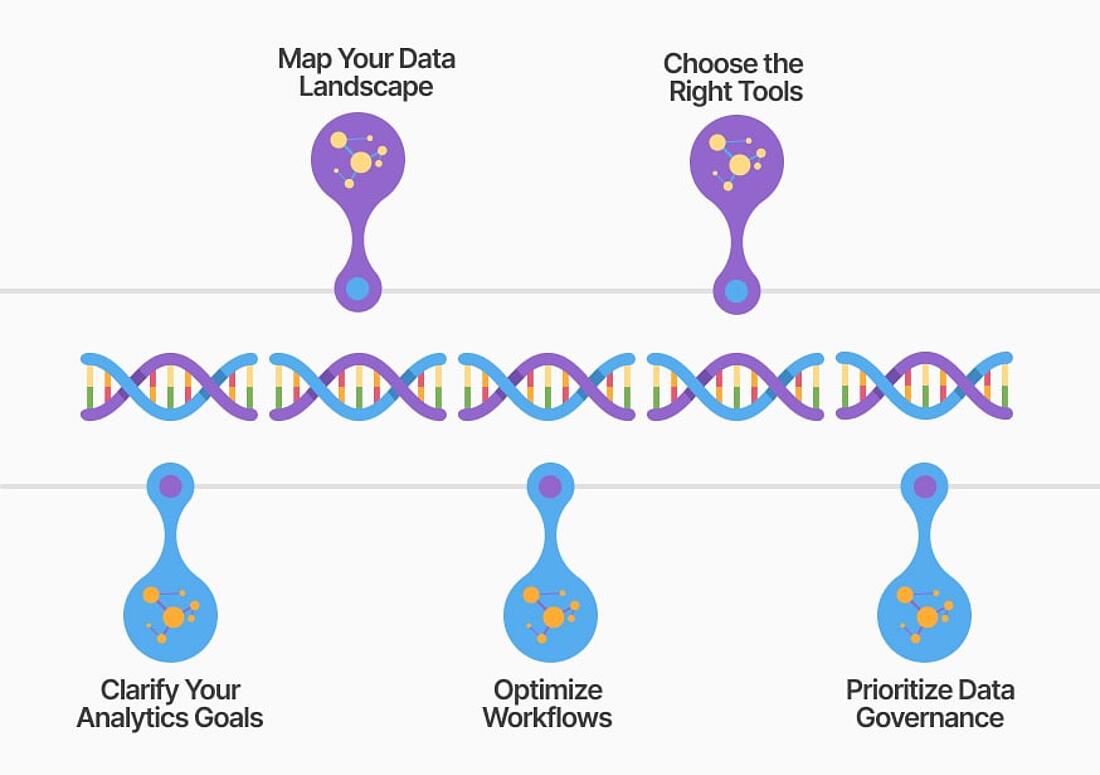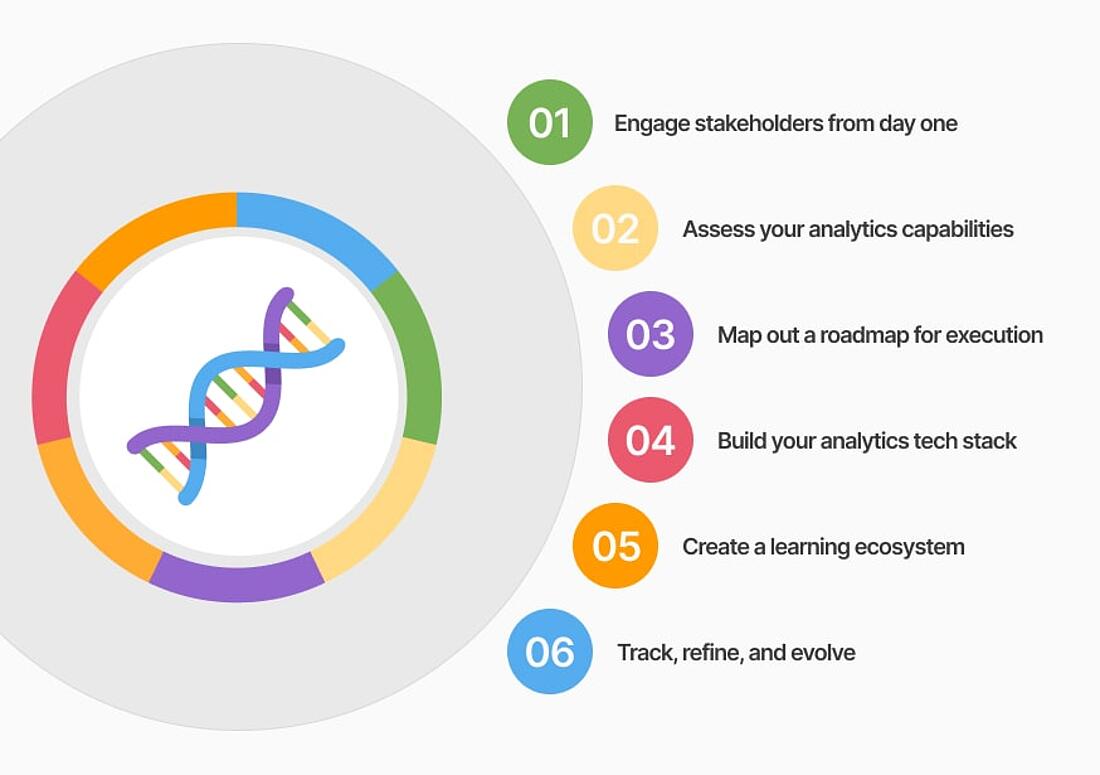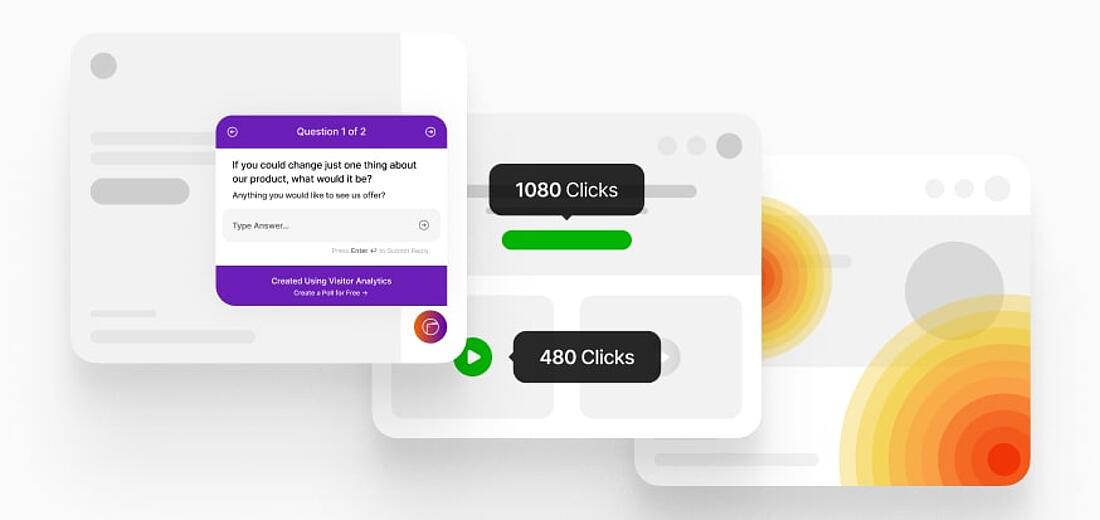- Why Us?
- Features
White Label
For SaaS Platforms & Agencies
Provide our complete analytics suite to your clients, directly within your own interface and with your/their own branding. Discover Analytics-as-a-Service and White Label Analytics. Great benefit, minimal effort.
- Pricing
- White Label
- Success Stories
- ResourcesGetting Started
CONTENTS
- The DNA of a Powerful Data Analytics Strategy
- Clarify Your Goals
- Map Your Data Landscape
- Optimize Workflows
- Choose the Right Tools
- Prioritize Data Governance
- 6 Steps to Execute a Winning Data Analytics Strategy
- 1. Engage Stakeholders from Day One
- 2. Assess Your Current Analytics Capabilities
- 3. Map Out a Roadmap for Execution
- 4. Build and Scale Your Analytics Tech Stack
- 5. Nurture a Learning Ecosystem
- 6. Track, Refine, and Evolve
- How TWIPLA Can Help With Your Data Analytics Strategy
Craft a Successful Data Analytics Strategy in 6 Steps

Data drives modern decision-making, yet harnessing its full potential requires more than just collecting numbers.
This blog explores the essentials of a powerful data analytics strategy, guiding you from defining your goals to building scalable workflows. We'll also cover actionable steps to execute your strategy, highlight the importance of data governance, and explain how tools like TWIPLA can support your journey.
Whether you're new to analytics or looking to refine your approach, this comprehensive guide has everything you need to get started.
The DNA of a Powerful Data Analytics Strategy
Creating an effective data analytics strategy requires a deep understanding of your organization's unique needs and challenges.
This section will explore the foundational elements of a strong strategy, including setting clear goals, understanding your data sources, streamlining processes, and choosing the right tools.
Each subheading below delves into a crucial step, providing practical insights to guide you toward building a framework that delivers actionable insights and drives success.
A robust data strategy framework should encompass clear objectives, relevant data sources, and tools that can adapt as your organization grows.
Clarify Your Goals
Every successful data analytics strategy begins with clear objectives.
Ask yourself: What do you want to achieve with your data?
Whether it's increasing sales, improving customer retention, or identifying inefficiencies, defining your goals sets the foundation for your entire strategy.
Goals give direction and help focus your efforts on meaningful outcomes.
Clear objectives also align with marketing compliance by ensuring your analytics adhere to legal and ethical standards - which also increases the likelihood that you'll be eligible for ESG funding.
This clarity is one of the vital data strategy components that can differentiate success from failure.
Map Your Data Landscape
Understanding where your data comes from and its current state is essential. Identify all your data sources - from website analytics to CRM systems.
Evaluate the quality of this data: Is it complete, accurate, and up-to-date?
Mapping your data landscape also means identifying areas where key information is missing, such as a lack of insights into visitor behavior on your website.
Filling these gaps ensures your strategy covers all the bases.
This process can highlight areas needing data privacy training to ensure your team handles sensitive information correctly.
A well-mapped data landscape is a cornerstone of any data analytics strategy roadmap.
Optimize Workflows
Data is only as useful as the processes around it.
Streamlined workflows enable you to efficiently collect, analyze, and act on insights.
Think about how data flows through your organization. Are there bottlenecks slowing things down?
Automating repetitive tasks, such as consent management, frees up time for strategic analysis.
Additionally, fostering collaboration between teams ensures everyone works toward shared goals.
Incorporating analytics reports into these workflows can make insights more actionable and accessible. These workflows form a critical part of your overall data and analytics strategy.
Choose the Right Tools
The tools you use can make or break your strategy.
Look for platforms that align with your needs and integrate well with existing systems.
Tools like TWIPLA, which offer features like heatmaps, session recordings, and data visualization, simplify analytics for even the least tech-savvy users.
There's no shortage of excellent analytics platforms on the market, and the right choice will empower your team to make data-driven decisions with confidence.
Additionally, ensure these tools support compliance audits, providing transparency and accountability in how data is managed.
Choosing adaptable tools is integral to building a dynamic web analytics strategy.
Prioritize Data Governance
Data governance might sound intimidating, but it simply means managing data responsibly.
This includes aligning with specific regulations like GDPR and implementing practices that protect sensitive information throughout the data lifecycle.
Responsible governance involves ensuring the accuracy and security of your data while enabling compliance audits that can verify adherence to legal standards. It aligns compliance with regulations like GDPR, maintains data accuracy, and controls access to sensitive information, seamlessly integrating these aspects into your data governance framework.
A strong governance framework builds trust with stakeholders and protects your business from legal risks and GDPR penalties.
Remember, responsible data management isn't just a legal requirement - it's also good business.
Practices such as data minimization as well as data anonymization or pseudonymization simplify the compliance aspect of a data analytics strategy by ensuring only necessary data is collected and used.
These methods enhance the security of data storage, limit exposure to risks like breaches, and make it easier to comply with privacy regulations by reducing the sensitivity of stored data.
Incorporating these elements into your strategy also supports data strategy and governance objectives.
6 Steps to Execute a Winning Data Analytics Strategy
Executing a data analytics strategy successfully requires clear steps that translate high-level plans into actionable tasks.
This section will cover the crucial elements involved - from stakeholder engagement and assessing your current capabilities to building a scalable tech stack and refining processes.
By following these steps, you can create a roadmap that adapts to evolving needs while ensuring compliance and maximizing the value of your data.
1. Engage Stakeholders from Day One
Involving key stakeholders early in the process ensures alignment and support.
Stakeholders can include department heads, data analysts, and even IT teams.
By engaging them, you create a shared understanding of the strategy's goals and gather valuable input. Collaboration fosters buy-in and increases the likelihood of success.
2. Assess Your Current Analytics Capabilities
Before moving forward, take stock of your existing analytics setup.
Are your tools adequate for your goals? Do you have the right talent in place to interpret data? Maybe you have provided access to a strong analytics suite, but do your employees know how to use session recordings effectively?
Identifying your strengths and weaknesses helps you prioritize improvements and allocate resources effectively.
A thorough assessment sets the stage for growth. Include a review of your compliance audit history to ensure your practices align with regulations and best practices. This evaluation forms a key step in your data strategy framework.
3. Map Out a Roadmap for Execution
A clear roadmap keeps your strategy on track.
Break your plan into manageable steps with specific deadlines. For example, start with improving data collection processes with the help of a good cookieless tracking solution, then move on to implementing new tools.
Regularly revisit the roadmap to ensure progress and adjust as needed.
Having a roadmap provides clarity and keeps everyone focused. The roadmap should also consider the entire data lifecycle, from collection to analysis to storage and eventual deletion or anonymization.
This step ties directly into the creation of an actionable data analytics strategy roadmap.
4. Build and Scale Your Analytics Tech Stack
Your tech stack is the collection of tools and technologies you use for analytics.
Start small with essential tools and expand as your needs grow.
Scalability is key - your tools should grow with your business.
Platforms like TWIPLA are designed to be flexible, accommodating everything from small businesses to enterprise-level operations.
Secure data storage should be a cornerstone of your tech stack, ensuring that sensitive information is protected against breaches.
Survey results also show that GDPR compliance is equally important because of the way this feature will streamline wider processes and practices.
A well-designed tech stack is integral to effective analytics strategies.
5. Nurture a Learning Ecosystem
Creating a culture of continuous learning around analytics sets you apart.
Offer GDPR training sessions, share resources, and encourage curiosity.
When teams understand the value of data and feel confident using it, they’re more likely to embrace analytics.
A learning ecosystem fosters innovation and ensures long-term success.
Data privacy training can be a valuable addition, helping employees understand the importance of compliance and secure data practices.
Incorporating these elements ensures your data strategy components are robust and comprehensive.
6. Track, Refine, and Evolve
Analytics is not a one-and-done effort. Continuously monitor your performance and refine your strategy based on the insights you gather.
Metrics like conversion rates, bounce rates, and customer satisfaction scores provide valuable feedback.
By evolving your approach, you stay ahead in a rapidly changing landscape.
Regular reviews can also help identify vulnerabilities in your system, such as risks of a data breach, and implement preemptive solutions.
Refining your processes ties into broader elements of data governance and enhances your data-driven strategy.
How TWIPLA Can Help With Your Data Analytics Strategy
TWIPLA is designed to simplify the complex world of data analytics.
With features like session recordings, event tracking, and custom dashboards, our website intelligence solution provides precise, actionable insights that can be used as a guide to online success.
Its user-friendly interface ensures even beginners can harness the power of data.
Additionally, TWIPLA's privacy-first approach ensures compliance with regulations, giving you peace of mind as you grow your analytics capabilities.
We use practices like data minimization and anonymization, which simplify the compliance aspect of a data analytics strategy while reducing risks associated with data breaches.
Whether you're starting small or scaling up, TWIPLA supports your journey every step of the way.
By following these steps and leveraging the right tools, you can build a data analytics strategy that drives success.
Remember, it’s not about collecting data - it’s about turning data into decisions that propel your business forward.
Share article
Get Started for Free
Gain World-Class Insights & Offer Innovative Privacy & Security

You might also like
19 Common 4xx Errors: Quick Definitions & Solution Ideas 03 December 2024 - by Simon Coulthard
03 December 2024 - by Simon Coulthard
TWIPLA vs GA4 vs AWStats: Comparing Dataset Quality 07 August 2024 - by Simon Coulthard
07 August 2024 - by Simon Coulthard
Safari Browser Blocks Adobe Tracking Pixels 23 June 2024 - by Simon Coulthard
23 June 2024 - by Simon Coulthard












